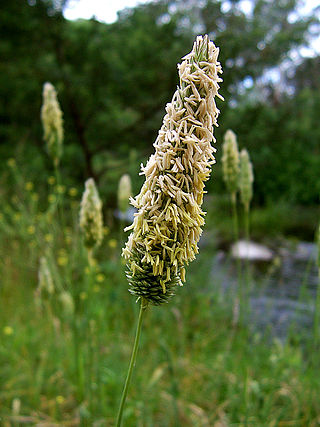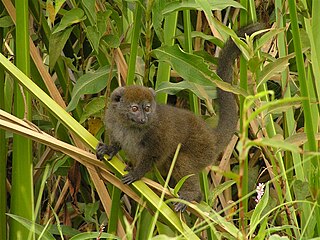
Reed is a common name for several tall, grass-like plants of wetlands.

Reed is a common name for several tall, grass-like plants of wetlands.
They are all members of the order Poales (in the modern, expanded circumscription), and include:

Many different cultures have used reeds in construction of buildings of various types for at least thousands of years. One contemporary example is the Marsh Arabs.

Phragmites australis , the common reed, is used in many areas for thatching roofs. In the United Kingdom, common reed used for this purpose is known as "Norfolk reed" or "water reed". However, "wheat reed" and "Devon reed" are not reeds but long-stemmed wheat straw.
Ancient Greeks used Arundo donax to make flutes known as kalamaulos; this is a compound word, from kalamos (cane) + aulos (flute). At the time, the best cane for flutes came from the banks of river Kephissos, in Attica, Greece. Several kalamaulos tuned differently and tied together, made a syrinx or Panpipes. A. donax is still the principal source material of reed makers for clarinets, saxophones, oboes, bassoons, bagpipes, and other woodwind instruments. [1] The Var country in southern France contains the best-known supply of instrument reeds.
Bamboo and, even more commonly, rattan stems are used as "reed sticks" to wick and disperse the scent of essential oils in aroma diffusers. (See Rattan § Food source.)


Woodwind instruments are a family of musical instruments within the greater category of wind instruments. Common examples include flute, clarinet, oboe, bassoon, and saxophone. There are two main types of woodwind instruments: flutes and reed instruments. The main distinction between these instruments and other wind instruments is the way in which they produce sound. All woodwinds produce sound by splitting the air blown into them on a sharp edge, such as a reed or a fipple. Despite the name, a woodwind may be made of any material, not just wood. Common examples include brass, silver, cane, as well as other metals such as gold and platinum. The saxophone, for example, though made of brass, is considered a woodwind because it requires a reed to produce sound. Occasionally, woodwinds are made of earthen materials, especially ocarinas.

Poaceae or Gramineae is a large and nearly ubiquitous family of monocotyledonous flowering plants commonly known as grasses. It includes the cereal grasses, bamboos and the grasses of natural grassland and species cultivated in lawns and pasture. The latter are commonly referred to collectively as grass.

A reed is a thin strip of material that vibrates to produce a sound on a musical instrument. Most woodwind instrument reeds are made from Arundo donax or synthetic material. Tuned reeds are made of metal or synthetics. Musical instruments are classified according to the type and number of reeds.

Arundo is a genus of stout, perennial plants in the grass family.

Rattan, also spelled ratan, is the name for roughly 600 species of Old World climbing palms belonging to subfamily Calamoideae. The greatest diversity of rattan palm species and genera are in the closed-canopy old-growth tropical forests of Southeast Asia, though they can also be found in other parts of tropical Asia and Africa. Most rattan palms are ecologically considered lianas due to their climbing habits, unlike other palm species. A few species also have tree-like or shrub-like habits.

Phragmites is a genus of four species of large perennial reed grasses found in wetlands throughout temperate and tropical regions of the world.

Arundinaria is a genus of bamboo in the grass family the members of which are referred to generally as cane. Arundinaria is the only bamboo native to North America, with a native range from Maryland south to Florida and west to the southern Ohio Valley and Texas. Within this region Arundinaria canes are found from the Coastal Plain to medium elevations in the Appalachian Mountains.

A double reed is a type of reed used to produce sound in various wind instruments. In contrast with a single reed instrument, where the instrument is played by channeling air against one piece of cane which vibrates against the mouthpiece and creates a sound, a double reed features two pieces of cane vibrating against each other. This means, for instruments with the double reed fully exposed, that the air flow can be controlled by the embouchure from the top, bottom and sides of the reed. The term double reeds can also refer collectively to the class of instruments which use double reeds.

A reedbed or reed bed is a natural habitat found in floodplains, waterlogged depressions and estuaries. Reedbeds are part of a succession from young reeds colonising open water or wet ground through a gradation of increasingly dry ground. As reedbeds age, they build up a considerable litter layer that eventually rises above the water level and that ultimately provides opportunities in the form of new areas for larger terrestrial plants such as shrubs and trees to colonise.

Cynodon is a genus of plants in the grass family. It is native to warm temperate to tropical regions of the Old World, as well as being cultivated and naturalized in the New World and on many oceanic islands.

Arundo donax is a tall perennial cane. It is one of several so-called reed species. It has several common names including giant cane, elephant grass, carrizo, arundo, Spanish cane, Colorado river reed, wild cane, and giant reed. Arundo and donax are respectively the old Latin and Greek names for reed.
The term Elephant grass may refer to the following grass species:

Jerdon's babbler is a passerine bird native to wetlands and grasslands of the Indian sub-continent. It is listed as Vulnerable on the IUCN Red List since 1994. It is a member of the genus Chrysomma of the family Paradoxornithidae.

The Lac Alaotra bamboo lemur, also known as the Lac Alaotra gentle lemur, Alaotran bamboo lemur, Alaotran gentle lemur, Alaotra reed lemur, or locally as the bandro, is a bamboo lemur. It is endemic to the reed beds in and around Lac Alaotra, in northeast Madagascar. It is about 40 cm (16 in) long, with a similar length tail, and is a brownish-gray colour. It is the only bamboo lemur to live in and feed on papyrus reeds, and other reeds and grasses, and some authorities argue that it should be regarded as a subspecies of the eastern lesser bamboo lemur. The population of this lemur has been declining because of habitat destruction and the International Union for Conservation of Nature has rated it as being "critically endangered".
The Titarisios is a river in Thessaly, Greece. It is a major tributary of the Pineios. The river begins at the western slopes of Mount Olympus and flows southwest, then south. It leaves the mountains near the village Sykia, and turns east near the village Vlachogianni. It passes along the town Tyrnavos and flows into the Pineios near the village Rodia. The confluence is at 65 m above sea level. Its total length is 70 km, and for most of its length it contains water throughout the year.

Phragmites australis, known as the common reed, is a species of flowering plant in the grass family Poaceae. It is a wetland grass that can grow up to 20 feet tall and has a cosmopolitan distribution worldwide.

Cape Lowland Freshwater Wetland is a critically endangered vegetation type of the Western Cape, South Africa.
Carrizo ("reed") is the Spanish vernacular name of the following plants found in a carrizal :

Coccidula rufa is a species of beetle in family Coccinellidae. It is found in the Palearctic The beetles are found throughout Europe except in the far north North Africa and East across the Palearctic - Turkey, European Russia, the Caucasus, Siberia, the Russian Far East, Belarus, Ukraine, Moldova, Transcaucasia, Kazakhstan, Middle Asia, Western Asia, Afghanistan, Mongolia. They occur to an altitude of about 1000 meters.he preferred habitat is damp areas with swamp and water plants - slack and marshes, including peatlands but Coccidula rufa also occurs in dry biotopes They eat aphids which they hunt on aquatic plants such as cane, reed, sedges, and gramineans in the genera Glyceria and Elymus They eat aphids which they hunt on the aquatic plants, especially Hyalopterus pruni which lives not only on Prunus species such as Prunus spinosa, but also on reeds, Arundo donax and Molinia caerulea. Overwintering takes place in the reed.
Nipponaclerda biwakoensis is a scale insect originally described from Japan, and naturally occurring in China; in these countries it is most often associated with reeds in the genus Phragmites. This species has become established in the United States in the state of Louisiana, where it has rapidly become a serious pest of roseau cane, damaging over 80% of the reeds in some areas such as the Pass a Loutre Wildlife Management Area, where it is referred to by the older common name Phragmites scale insect or the more recently-coined name, roseau cane mealybug. Several species of parasitoid wasps are known to attack this scale, with initial investigations focusing on the species Neastymachus japonicus, known only to attack this one pest.